Compact Biogas Plant
AD Karve, Appropriate Rural Technology Institute, Pune, India April 2005
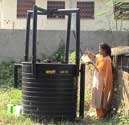 |
Dear Friends,
For those of you interested in compact, low cost digesters for bio-gas production, I have put together a compilation of information clipped from postings and personal correspondence with Dr. A. D. Karve of Pune, India. Dr. Karve is the developer of an innovative system of bio-gas generation using any waste (or non-edible) starchy and sugary feedstocks. This information is presented with Dr. Karve's permission to promote further development and dissemination of this new and evolving technology.
Robert Deutsch, Advisor
Community Sanitation and Recycling Organization
Phnom Penh, Kingdom of Cambodia
www.online.com.kh/users/csaro
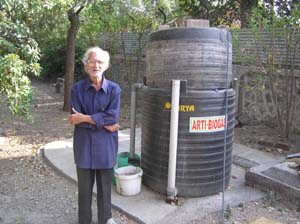
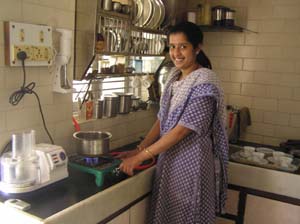
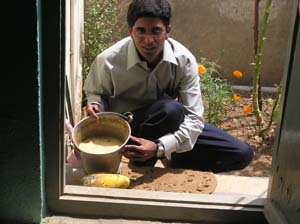
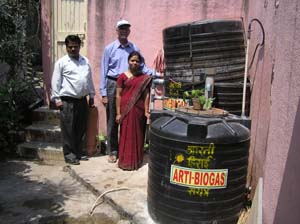
=========================================================================
Compact, low-cost digester for biogas from waste starch
Note: The following text was cut and pasted from a number of public exchanges discussing an experimental method for production of bio-gas from various starchy and sugary feed stocks developed by Dr.A.D.Karve ( adkarve at pn2.vsnl.net.in ), President, Appropriate Rural Technology Institute, Pune, Maharashtra, India. Dr. Karve was the winner of the prestigious Ashden award in 2002 for a different stove development and one of the four winners of the 2004 Shell Foundation stove dissemination grants.
These exchanges mostly took place on the REPP discussion group on energy efficient stoves over the last 18 months. Almost all of this text was culled from the posting by the main developer and promoter of the method, Dr. A.D. Karve, although quotes and questions from several others are included. As these messages discuss the development of this new approach over a period of some 18 months, there are some obvious contradictions in the data reflecting the progressive nature of the research.
R. Deutsch, robdeutsch at online.com.kh
===================================================================================
Introduction
Preliminary studies indicated that the amount of biogas produced and the retention period varied from feedstock to feedstock and from season to season. Also, when the feedstock was changed from one form to another, the system took a few days to stabilise. Our studies also indicated that the gas yield could be increased by using combinations of feedstock materials. We are now looking at additives such as micronutrients, nitrogen, phosphorous compounds etc., which might bacterial action and yield more gas at a faster rate. Since the users would depend mainly upon locally available feedstock, field trials are essential to determine the retention periods and gas yield for different raw materials.
Many people in India, who read my article in a local newspaper, copied our design and have started to use this biogas plant in their households. A schoolgirl submitted a working model of it in a statewide science project competition and won the first prize in the state. A company supplying science equipment to educational institute wants to manufacture models (50 litre capacity) for supply to schools and colleges.
We have supplied 200 litre models to 10 voluntary agencies in different regions for demonstrating this technology to villagers in their respective areas. This model is meant for areas where the main diet is rice. This model yields enough gas to operate a pressure cooker to cook rice, beans, vegetables or meat for a family of five. In areas, where the main diet of the people consists of unleavened flat bread, somewhat like the tortilla, each piece of bread is made individually, and therefore the stove has to be in operation for a longer time. In such cases, we recommend the five hundred-litre model.
The fermenter vessel contains almost 200 litres of liquid. When you pour a few litres of feedstock slurry into the biogas plant, a corresponding quantity comes out of the outlet pipe. Because the material to be fed into the biogas plant consists mainly of starch and sugary material like sugarcane juice or fruit pulp, the slurry consists almost exclusively of water with a little suspended matter in it. In the case of cattle dung or municipal solid waste, the slurry is thicker, because the feedstock material contains a lot of cellulose and lignin, which are not as easily digestible as starch or sugar.
It may also be theoretically possible to produce alcohol and methane simultaneously, but we haven't looked for alcohol. The system however runs on vinegar, which is the oxidised product of alcohol. The system is sensitive to temperature. Here in Pune it is not as cold as in the US, but at present the night temperatures touch 10 degrees C. This lowering of the night temperature has reduced the gas outflow considerably. However, it would not be difficult to cover the drums with an insulating material and conserve the heat produced by the bacterial process. I t would however add to the cost of the system.
Let me also correct a fallacy that is current among scientists and laymen alike. The fact, that methanogenic bacteria are found in the excreta of animals, led people to think that dung was their food. It is not. One should take the advice of Mark Twain, namely not to allow school to interfere with one's education, seriously. These bacteria live in our intestines and eat whatever we eat. They are swept out of the intestine along with undigested food and therefore they are found in the faeces. Because dung is not the food of these bacteria, they have to take the help of several other species of faecal bacteria, which break down the dung into sugars and organic acids, before the methanogenic bacteria can convert them into methane. As a result, the quantity of methane produced from dung (and distillery effluent, paper factory waste, municipal solid waste etc.) is very low in proportion to the feedstock used, and secondly, it also takes a lot of time.
It is stated in the standard textbooks on biogas technology, that 1 kg of starch or sugar produces about 800 litres of biogas, out of which about 400 litres are methane. In our biogas plants, the reaction time of the starch-to-methane process is 8 hours. Theoretically, the product should also contain equal volume of carbon dioxide, but in the system that we are using, the carbon dioxide dissolves in the water in the fermenter and diffuses out of the fermenter through the gap between the fermenter vessel and the moving dome. After seeing the analysis of our biogas, somebody suggested that we could use our gas for a driving a car. We do not have the compressor to put the gas into a cylinder, but we operated a petrol driven portable electricity generator for about two hours, using just the biogas produced from oilcake.
The conventional biogas plants use feedstock having high organic carbon content but low calorific value. It is a universal rule that every output of work requires a corresponding input of energy. In the conventional biogas plants, the conventional feedstock is low in physiologically available calories. So naturally the gas output is also low. The stovers understand calories. When talking with stovers about fuel, the first question that is asked is about the calorific value of the fuel. But apparently the biogas workers do not understand calories. They talk of C/N ratio, organic matter that can be volatilized and many other things, which make no sense to me
Methane may also explode, as in the cylinder of an internal combustion engine, if it is mixed with the appropriate quantity of oxygen. But under the anaerobic conditions under which methane is produced and stored, it would not explode or burn as long as it is inside the gas holder or inside the fermenter. You also asked me if agricultural crop residues could be used for producing methane instead of making charcoal. Unfortunately, the anaerobic bacteria cannot digest lignin. Woody and lignified crop residues like cotton stalks, sugarcane leaves or wheat straw have to be first decomposed by aerobic organisms. The digested mass is then fed into a biogas digester. This is called two stage fermentation. It is used for agricultural residues and also for municipal solid waste, but not in a domestic methane fermenter, because the added cost of the extra fermenter and the extra space required by the system.
[Peter] For the other stovers on the list -- sugar cane is a wonderfully productive plant for any place in the tropics. Very easy to grow. For a large percentage of the world's poorest populations it is feasible to have a small plot of cane. This certainly would solve the "where do we find all the biomass to burn" problem!
Our biogas plant accepts both sugarcane juice as also macerated whole sugarcane. In the case of the latter, the advantage is that the cellulose in the cane is also converted into gas, albeit after a retention period of about 20 days. The maceration is done with the help of a machine called the chaff cutter, which is used for chopping stems of sorghum or maize into small pieces. One can set the machine to give different sizes of the chopped up material. We use the setting for the smallest pieces. Under Indian conditions, where we get rains only during the four months of monsoon, sugarcane needs irrigation. Therefore it is not such a simple crop to grow and it is also costly. There are many crops that produce starchy material (e.g. sorghum, pearl millet, sweet potato and several perennial tree species). Many of them can be grown purely under rainfed situations, and therefore starchy material is generally cheaper. It can also be stored more easily than sugarcane juice or sirup.
I have not patented my biogas plant as I use the same standard design. The fact that one can get methane from starch or sugar is also not my invention. This is common information to everybody in the biogas game. Many people have reported high biogas yields with oilcakes. There was however a general tendency among all workers to use only waste material such as animal dung, municipal solid waste, distillery effluent etc. as the raw material for making methane. All that I did was to conduct some experiments with starchy and sugary material. When I got good results, I started to search for such material that could be used as feedstock without competing with human or animal food, and found that farmers generally have a lot of starchy and sugary material, which they considered as waste. One can of course have commercial methane production using commercially grown starchy material such as sorghum or tapioka. The farmer does not care for what his produce is being used for, after he has sold it. In fact none of our technologies is patented, as we want them to reach the people who are need of them. As to diversifying our operation to other areas, would certainly like to do it, if the money is made available for it.
Now that we are on the way to getting a grant from USEPA, we want to scale up the manufacture of the present model with the help of a plastic manufacturer. It is our aspiration that the model, having a gas holder of 500 litre capacity should not cost more than about US$50. The gas stove with two burners costs US$20. The total expenditure is about the same as the present price of an LPG system, which includes the deposit for the LPG cylinder. Anybody who has already installed a conventional biogas system in his house, has only to switch from dung to the new feedstock. Many people have already done it.
Construction
As far as the biogas fermenter is concerned, it is a small version of the standard moving dome Biogas plant, a very simple contraption consisting of two drums, telescoping into one another. the outer drum is open at the top and the inner one is open at its bottom. The outer drum is filled with the material to be fermented and the inner drum is lowered into it. A tap at the top of the inner drum is kept open while lowering the drum into the outer one, and when it has been completely inserted into the outer drum, the tap is closed. The gas accumulates in the inner drum which gets lifted up due to increased buoyancy. (If a girl falls accidentally into water, she should not remove her dress because the air caught in the dress acts like a buoy :-))The inner drum is provided with a tap at the top, through which the biogas can be led to the burner. Both the drums have a capacity of approximately 200 litres.
The biogas plant consists of two cylindrical vessels telescoping into one another. The larger vessel, called the fermenter, has a total internal volume of about 500 lit. A drum having diameter of 85 cm and height of 85 cm would have the desired volume. The smaller vessel, which telescopes into the larger one, serves as the gas-holder. The diameter of the gas holder is about 2 cm smaller than that of the fermenter. The fermenter vessel is provided with appropriate inlet and outlet pipes for introducing the feedstock into it and for removal of spent slurry from it. The gas holder is provided with a gas tap, through which the gas is led to the burner.
The size of the gas holder may vary between 500 litres and 1000 litres depending upon the requirements of the family. In a family eating mainly rice or noodles, a capacity of 500 litres is adequate, but in the case of families eating chapattees or rotis, which have to be made one after the other, the gas has to last longer, and therefore a larger capacity of gas holder and fermenter are required
We generally use tanks of 750 litre capacity. The digester tank is made of bricks and cement.
There is no stirring mechanism. We are not looking at any special bioculture, as it would get contaminated under the conditions under which our biogas plants would be operated.
Is this device difficult to build?? A: A schoolgirl submitted a working model of it in a statewide science project competition and won the first prize in the state.
Starter and Feed stock
We do not use any special bacteria. To begin with we mix about 10 kg cattle dung and water and pour the slurry into the fermenter. However, to make the system more readily acceptable to the users, we shall have to produce the culture ourselves and give it to the users along with the biogas plant. Dung is a dirty and smelly material. In the initial phase, we add daily just 200 grams of flour. After the methane production has started, we increase the daily dose of 1 kg starch at each feeding
You have to use dung for starting the gas plant. It can come from any animal, not necessarily a cow. You can add starch to a dung based gas plant, if the dung is not available in adequate quantity.
We use dung only to start the process, and once the gas emanation starts, we add only starchy material. You can also use rotten or misshapen fruits, powdered seed of any plant, leftover food etc.
20 kg fresh dung of water buffalo is what we normally use as the starter culture. We would like to know, if dried dung would also work as a source of culture, because demand for our biogas plant is on the rise in the peri-urban areas, where animal dung is not very easily available, and where the aesthic sense of the middle-class housewives comes in the way of their handling fresh dung.
Several prototypes, in operation for more than a year, have been successfully tested using various feedstocks. The potential candidate feedstocks, namely rain damaged or insect damaged grain, flour spilled on the floor of a flour mill, oilcake from non-edible oilseeds, seed of various tree species, non-edible rhizomes (banana, arums, dioscoreas), leftover food, spoiled and misshapen fruits, non-edible and wild fruits, spoilt fruit juice, etc. are readily available in rural areas.
Maize flour is an excellent feedstock for a biogas digester. One would get about 250 g of methane from 1 kg of maize flour. Methane would have a calorific value of about 11000kCal/kg. So the 250 g would have about 2750 kilocalories.
"Our studies also indicated that the gas yield could be increased by using combinations of feedstock materials. We are now looking at additives such as micronutrients, nitrogen, phosphorous compounds etc."
How about using molasses from cane sugar processing in the compact biogas plant, is that possible? Musungu. Yes, molasses should work.
Because the effluent also consists of bacteria, and because the quantum of the effluent is very small (just a few litres), we mix the starch powder or fruit pulp into the effluent slurry and recycle it. We are currently advocating that the feedstock be fed into the biogas plant once in the morning and once again in the evening. Because the reaction time is short, one can theoretically have a continuous drip feed, but the relatively high viscosity of the feedstock may cause mechanical problems like clogging of the dripper.
Process
About two kg dry starchy matter mixed in about 10 litres of water is the daily input. The retention time ranges from 12 to 24 hours, depending upon the temperature.
Our model that we are currently propagating has a gas holder tank of 550 litre capacity, having about 500 l usable gas holding space. We advice the housewife to introduce a kg of feedstock once in the morning and again in the evening. Everytime she gets about 500 litres of gas, which is enough to cook one meal for a family of five. Families eating only rice may require just half of this quantity of gas. The majority of people in this state eat a tortilla like flat unleavened bread. Since these are made serially, it takes longer to make them. The dry feedstock is stirred in about 5 litres of water to form a slurry, which is then poured into the gas plant through the inlet port.
When gas starts emanating, we test it for its combustibility. We get combustible gas in 7 to 15 days. . The inlet and outlet pipes have a diameter of about 5 cm.
Production
This system uses starchy or sugary material as feedstock. 1kg of sugar or starch yields about 400 litres of methane, within a period of 6 to 8 hours. This quantity is enough for cooking one meal for 5 to 6 persons. The biogas produced by this system contains theoretically about equal volumes of carbondioxide and methane, but in reality, it turned out to have less than 5% carbondioxide. This phenomenon is explained by the fact that carbon dioxide dissolves in the water in the fermenter vessel and diffuses out of it through the 1 cm gap between the fermenter and the gas holder.
We are getting about 250 g of methane per kg of flour. The values are approximations based on the volume of the gas and the crude analysis that was done in a chemistry lab. We are making arrangements with a government certified analytical lab for getting both the gas and the slurry analysed, and hope to come out with more reliable figures. The grain flour contains almost 10% protein and about half a percent of seed coat material, along with small quantities of fat in the embryo.
Mr. Malar wanted to know the production potential of oilcake to methane. The biodigester working on oilcake of Madhuka indica actually uses 30 to 32 kg of oilcake (and not 16) to produce about 15 cubic meters of methane. The time taken by this reaction is just 24 hours. The weight of methane produced would be about 5.5 kg, having a clorific value of roughly 10,000 KCal/kg.
[ From Nandu] Because of the residual oil and the high protein content of the oilcake, its calorific value is much greater than that of starch from cereal grains, rhizomes or tubers. As a result, this particular system is 1600 times as efficient as the conventional biogas plants. Another person, with whom we are collaborating, has a biogas plant producing daily 40 cubic meters of gas. He used to feed it daily with 1000kg dung, but now he is using daily a mixture of 200 kg cattle dung and 15 kg sorghum grain flour. He is reluctant to switch over completely to sorghum, as he feels that the bacteria may go on strike if they did not get their daily dose of dung. In his case, he replaces 800 kg dung by 15 kg flour and reduces the reaction time from 40 days to one day. He thus gets an efficiency that is 2000 times that of the traditional system. In the moving dome reactors that we use, the gas holder telescopes into the fermenter. Therefore, the total volume of the system is twice that of the volume of the gas that you expect to get from it.
Starch, sugar, powdered oilcake, grain flour or powdered seed of any plant, take about the same time to digest and also produce the same amount of gas. It is likely that our high methane content is a result of a reaction 4H2 + CO2 = CH4 + 2H2O. Because very little work has been done by scientists on use of high calorie feedstocks, there is quite a lot of speculation about the high methane content that we are getting.
Under our temperature and pressure, 1 cubic meter of biogas produced by a typical dung based biogas plant (50% each of CO2 and CH4) weighs about a kg. CH4 is about a third as heavy as CO2., therefore, in this case, 500 litres of CH4 would weigh about 250 g and the remaining 500 litres of CO2 would weigh about 750 g. I our case, we get almost pure methane, and it takes about 1 kg of flour to produce 500 litres of it. Therefore we came to the conclusion that our biogas plant gives 250 g of methane per kg of feedstock. We haven't found much difference in different species of grain
I wish to correct the figures of oilcake used and biogas generated. It takes daily about 30 kg oilcake to produce 15 cubic meters of gas. But this gas consists of almost pure methane. It is not a case of co-generation, but direct fermentation. Cattle dung was used only initially as a source of bacteria, but for more than a month, they are using only oilcake.
I had never heard of the digestion accelerator, but would love to have it, if it is genuine. In any case, our biogas plant uses waste starch or sugar in any form. Thus spoilt bananas, oilcake of nonedible oilseed (e.g.castor or Jatropha), mango kernels, seed of practically any plant, rain damaged grain, etc. all work beautifully as feedstock. The material must be pulped or powdered. These substances are highly digestible and the methane production starts within a few hours after their introduction into the biogas plant. About 2 kg of dry matter in any of the above forms would yield about 500 g of pure methane in about 8 hours. This period can be halved by heating the biogas plant.
Advantages
The short retention time and the small feedstock quantity enabled us to reduce the size of the gas plant. Our biogas plants have a floating dome that acts as a gas holder, whereby the dome is a plastic water tank that is available in the market.
We have installed almost 100 biogas digesters operating on starch, and all are working without any hitch
Even industrialists are interested in this technology, because the LPG for industrial use costs almost twice as much as LPG for domestic use.
The retention time of dung in the dung-based biogas fermenter is 6 weeks, while that of starch is only 6 hours, which is why the volume of the fermenter could be reduced. The biogas produced from starch has about 60% methane by weight, while that produced from cattle dung has only 25% methane by weight. As a result even the 800 litres produced by my biogas plant is enough for cooking the meal of a family. We are trying to commercialise this new biogas fermenter. It costs only US$30 as against US$250 for the conventional biogas fermenter
The gas produced by this system has thus almost the same calorific value as LPG. It burns without smoke or soot, producing an almost invisible bluish flame similar to that of LPG.
This system is much easier to operate than the dung based biogas plant, because of the relatively small quantities of feedstock and effluent slurry to be handled. The effluent slurry generated daily by the plant is just a couple of litres. It can be used as manure for plants growing around the house. The 500 litre biogas plant, mass produced from moulded plastic drums, would cost about Rs. 3,500 (US$ 78). The smallest cattle-dung based domestic biogas plant costs about Rs. 12,000 (US$267). It requires daily 40kg dung, and owing to the retention period of almost 40 days, such plants have a minimum capacity of 2000 litres. They generate daily 80 to 100 litres of effluent slurry. Daily handling of such large quantities of feedstock and effluent is considered to be arduous and bothersome by users.
The residual slurry of a biogas fermenter is a good organic source of plant nutrients, because the process of methane formation removes CO2 and CH4 from the biomass. Because of the selective removal of these elements form the biomass, the other constituents such a N,P,K,Ca, Fe, etc. get concentrated in residual slurry.
The new system has a total internal volume of about 400 liters. Its small size allows the system to easily be accommodated inside the kitchen. It generates from 1 to 5 liters of effluent daily, which contains all the minerals in the original feedstock. Thus, the effluent can be used as manure. The prototype fermenter, in continuous operation for a year, has been successfully tested with various feedstocks such as waste flour collected from the floor of a flour mill, sugarcane juice, macerated sugarcane, leftover food, flour of no edible seeds, and powdered oilcake of no edible oilseeds. This technology does not rely on products meant for consumption by humans or animals.
---------------------------------------------------------------------------------
From: adkarve
To: Robert Deutsch
Sent: Thursday, March 31, 2005 11:44 PM
Subject: Re: Text compiled from exchanges
Dear Robert,
I went through the extracts from the stoves list. I have no objection to any of the material being reproduced. However, some of it may need to be confirmed. The feedback from the users is that they would like to have more gas, about 1000 litres than the 500 litres that our present model delivers. This would raise the price of the gas plant by about Rs.1000 (US$ 22), if we purchased the existing water tanks for this purpose. We are however negotiating with a plastic manufacturer to get the tank at a lower price. We are also working on other feedstocks, which would be cheaper to use than the starchy or sugary feedstocks. I shall let you know about it when I a have the necessary data.
yours
A.D.Karve
See also: A.D. Karve,Gandhali Kulkarni,and Priyadarshini Karve Design and Testing of Compact Biogas Plant presented to ETHOS 2004, Seattle, Wa.
For additional information Search Discussion Archives for "compact biogas"
